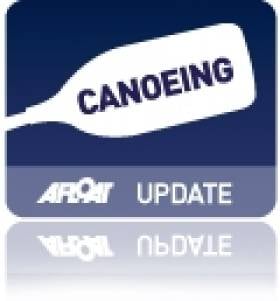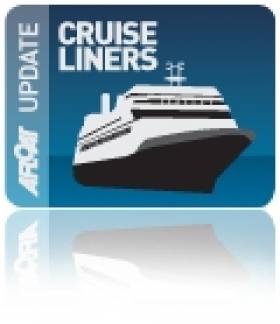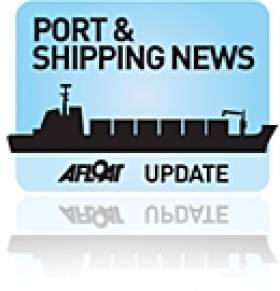Displaying items by tag: London Olympics
Rheinisch Penalty Costs Ireland in Semi Final
It all went wrong for Eoin Rheinisch in the semi final of the canoe slalom at the Olympic Games today. Surprisingly good times set by the early starters in the K1 at the Lee Valley course put pressure on the 32 year old Kildareman; but he was still in the mix to make the final until gates 18 and 19 which come after a big drop. He came through gate 18 but was carried too far and could not make it back to negotiate 19 (an upstream gate). He incurred a 50-second penalty and lost his chance of making the top 10 and progressing. He said afterwards that he was devastated and that the back of his boat had clipped the side of the course and he could not recover.
Chartered Cruiseships Gather for Olympic Games
#OLYMPIC CRUISESHIPS - Peter Deilmann's cruiseship Deutschland (1998/22,496grt) which called to Dublin Port at the weekend is en-route in the English Channel, having departed Plymouth bound for London, where she is set to became a floating hotel during the Olympic Games, writes Jehan Ashmore.
With less than four days to go to the start of the games, the 480 passenger capacity cruiseship has been chartered by the German Olympic Sports Federation. The vessel is scheduled to dock in West India Docks at the foot of the towering banking HQ offices in Canary Wharf.
Last year she made a trial visit, where she became the largest ever vessel to enter through the West India Dock lock. So with her return, she joins Fred Olsen Cruise Lines 929 passenger Braemar (1993/24,344grt) which as previously reported on afloat.ie is also on charter during the sporting spectacle, to the London Organization Committee of the Olympic and Paralympic Games (LOCOG).
The Bahamas-flagged vessel, formerly launched as Crown Dynasty for Crown Cruise Line, is moored in the East London Dock's Albert Dock basin at a berth facing opposite to the runway of London City Airport.
Astern of this vessel is Gemini (1992/19,093grt) which by coincidence is her sistership, having served as Crown Jewel, as both cruiseships were ordered by Crown Cruise Line from the Spanish shipyard of Union Naval de Levante in Valencia. However since change of ownerships, the Braemar was lengthened for her current operator.
As for Gemini likewise, she too has been chartered to LOCOG to accommodate personnel over the course of the games.
Tomorrow Noble Caledonia's 114-passenger Caledonian Sky is due in London too, the former Hebridean Spirit (1992/4,200grt) made a once-only cruise/promo call to Dun Laoghaire Harbour around a decade ago. The large yacht-like vessel will be accompanied by other 'private' luxury motor-yachts during the games, which were last held in the British capital in 1948.
Irish 49er Pair Claim Race Win at Sail for Gold (Video)
#sailforgold – Northern Ireland sailors Matthew McGovern and Ryan Seaton have made a good start at the Skandia Sail for Gold Regatta as they fine-tune their preparations for the Olympic Games.
The 49er class duo raced three times on the opening day at the Olympic venue in Weymouth, and claimed first place in the final race of the day.
After finishing eighth and 11th earlier, they are ranked ninth overall going into day two.
McGovern, 27, and Seaton, 24, qualified the nation in December at the World Sailing Championships in Australia, and London 2012 will be the first time since Athens 2004 that Ireland have been represented in the 49er event.
McGovern admits they are treating Sail for Gold as a dress rehearsal for the main event in under two months' time.
"We are trying to make this a bit like the Games with the atmosphere and personnel that are around, so we just trying to put a nice consistent solid week in," he said.
"The aim yesterday was just to make sure we didn't lose the regatta on the first day and I think the last race really paid off.
"We are trying to decide our final mast for the Games. We won't use our Games boat here but we will use our mast that we think we will probably want to use.
"We are doing a lot of tuning on that, so it's good from that point of view to be out with the other boats and race against them in the kind of conditions we hope to get in the Olympics.
"It looks like we are going to have a nice windy week later on which will be really good to check the rigging with that.
"Knowing that in eight weeks we will be back and it will be race time is really good.
"It's a really different regatta with a different vibe to it, and the whole being up in London for the opening ceremony is going to be pretty insane and we are really looking forward to it."
For more news on the Irish Olympic Sailing Team
For more: www.skandiateamgbr.com. Investment specialist Skandia is the principal sponsor of the British sailing team.
#PORTS & SHIPPING REVIEW – Over the last fortnight Jehan Ashmore reported the shipping scene which saw former Irish President Mary Robinson on board the National Geographic Explorer . She was a guest speaker during a 'Exploring the British Isles and Irish Isles' cruise.
An order for six 40,000 dwt bulk carrier newbuildings was placed by Irish based d'Amico Dry with China's Yangfan Group. D'Amico which is a fully owned subsidiary of the d'Amico group, has made the $134m deal, which values each handymax at $22.3m.
In advance of this weekend's visit of the London Olympic torch bearing tour to Ireland, the cruiseship Braemar called to Dublin Port. The vessel which was on a scheduled cruise is to be used as accommodation ship for key workers during the games for over a month, she is to moor close to the ExCEL Centre, which is to be used for a number of Olympic events.
On the ferry front the Isle of Man Steam Packet Company chartered the Arrow, a freight-ferry to cope with the increased volume in traffic associated with the famous annually held TT Races.
Along the south-west Irish coast, the small expedition cruiseship Clipper Odyssey made an anchorage call off Sneem on the Kenmare River. The 128 passenger vessel visited Co. Kerry having sailed the short distance from Cobh the previous day.
During the same week, two vessels met off Kilronan on Inishmore, Aran Islands. They were the cruiseship Island Sky which had started a cruise from Portsmouth and the lighthouse tender ILV Granuaile (2000/2,365grt) which is based in her homeport of Dun Laoghaire.
The last of the older Dublin Port tug fleet vessels Ben Eadar set sail on a delivery voyage for new owners in Portugal. While on the far side of the Irish Sea, the port of Liverpool welcomed its first turnaround cruise call in forty years in the form of Cruise & Maritime Voyages (CMV)'s Ocean Countess. However after leaving the Mersey, she suffered a temporary loss of engine power, forcing the vessel to turn around and divert to Holyhead.
Off the sunny south-east coast, the Expedition, a former Baltic Sea ferry converted to cruiseship duties anchored off the Saltee Islands. She sports a bright red hull still retained from her ferry owners, Viking Line, which the company choosed for their first ferry Apollo. Their choice in colour was found when one of the owner's relatives produced her lipstick!
Turning the corner at Carnsore Point and up to the boatyard of Arklow Marine Services where work on their latest newbuild Gardian 10 is nearing completion. The wind farm service vessel (WFSV) is due for launch later this month.

































































